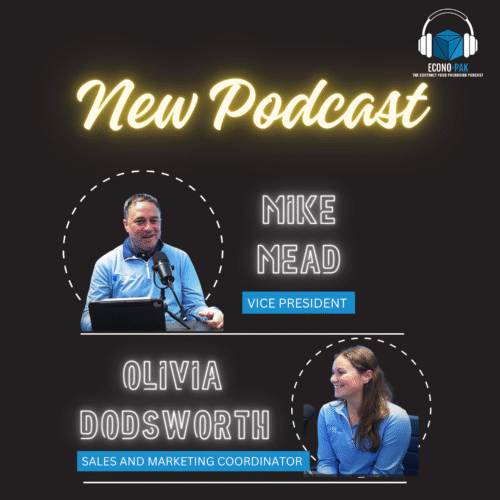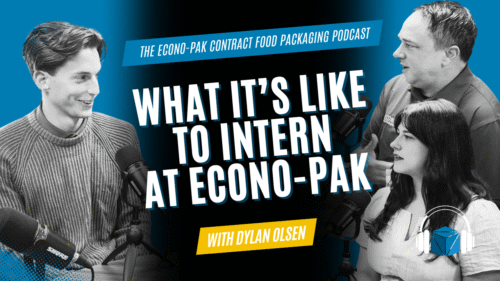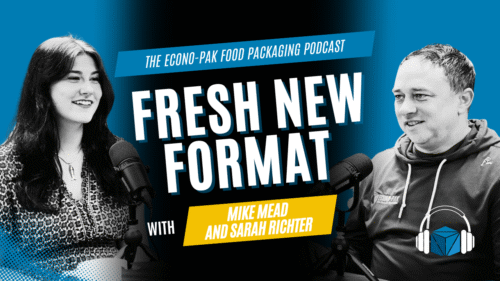In this episode of the Econo-Pak Contract Food Packaging Podcast, our hosts Sarah Richter and Mike Mead sit down with Tim Shay, Director of Procurement at Econo-Pak, to unpack one of the biggest topics in food packaging right now: Extended Producer Responsibility (EPR) and what it means for your packaging strategy.
As EPR laws begin rolling out in states like California, Colorado, and Oregon, brands are being asked to rethink their packaging materials, traceability, and long-term sustainability plans.
If you’re unfamiliar with EPR, it’s a new regulation already taking effect in several U.S. states, and more are expected to follow. It shifts responsibility for packaging waste back to the manufacturers and brand owners, which means added accountability and cost. But with that shift comes an opportunity to make smarter, more sustainable choices.
Tim walks us through how EPR is shaping material selection, pricing, and long-term planning, and how food brands can stay ahead by thinking sustainably today. We explore the pros and cons of different packaging formats, the role of post-consumer recycled content (PCR), and what it takes to innovate without compromising quality or compliance.
We also dive into how Econo-Pak is partnering with suppliers, learning alongside clients, and building a Learning Center to share knowledge that can help food businesses make smart, sustainable choices.
KEY TAKEAWAYS
- Extended Producer Responsibility (EPR) is here and food brands need to understand how it impacts packaging, cost, and compliance.
- Why now is the time to plan, test, and evolve your packaging strategy
- Industry collaboration is key, especially when it comes to sourcing and testing new materials.
- Econo-Pak is staying ahead by working closely with suppliers and clients to explore packaging that’s both sustainable and scalable.
- Solutions like PCR (post-consumer recycled content) can help brands meet new standards without sacrificing performance.
- The Econo-Pak Learning Center is being developed as a go-to hub for education, resources, and sustainability support.
TIMESTAMPS
00:00 – 07:21 What Is Extended Producer Responsibility (EPR)?
07:22 – 12:42 Tackling Challenges in Sustainable Packaging
12:43 – 14:44 Data, Compliance & Storytelling
14:45 – 16:51 Inside the Econo-Pak Learning Center
STAY CONNECTED
We’d love to hear from you!
- Follow the Econo-Pak Contract Food Packaging Podcast on Spotify, Apple Podcasts, or wherever you listen to your podcasts!
- Send us your questions or topic suggestions!.
Don’t forget to follow us on Facebook, Instagram, Linkedin, and YouTube!
TRANSCRIPT
SARAH
Welcome to the Econo-Pak Contract Food Packaging Podcast. I’m Sarah, the Sales and Marketing Manager, and we’re here with Mike, our Vice President, and Tim, our Director of Procurement. And today we’re going to be talking about EPR.
TIM
Extended Producer Responsibility. So it’s a policy-driven initiative that’s kind of taken root in five states so far. And essentially, it really shifts the burden of waste management that’s associated with packaging, consumer packaged goods, to the actual manufacturer, producer, more so than government, state, federal facilities.
So, I can remember growing up in school, and there was always this big push on recyclability, recycling all these things. Where does that infrastructure come from? So the government, right? But how do you quantify? Recycling all the components of every type of packaging there can be? It’s such a large landscape. And creating the equipment, the infrastructure to do so, is extremely cost-effective for 5% of the stuff that rolls through there. A lot of it is really difficult to recycle and get back into the recycling stream. So this is kind of an initiative that you’re going to be responsible for coming up with sustainable packaging that meets different levels of requirements that are going to be mandated at the state level thus far.
SARAH
So, like you said, there’s currently only five states that are mandated to do it right now, and it depends on the political landscape and everything, but we’re trying to be forward-thinking and bring this to light now in case it becomes more prevalent across the United States and try to educate people on what’s necessary to make sure you’re aligned with EPR.
TIM
Right, because just, I think, when I think about what’s the structure of this, how is it going to work, and just my mind shifts right to quality. There are so many third-party quality organizations that help that, and help ensure compliance in different aspects of everything in manufacturing. It’s going to be the same thing for this EPR. They’re going to have producer responsibility organizations that are going to be rooted in whatever the compliance is of the state. In its infancy right now, state level, it’s probably going to grow nationally, federal-backed. And you’re going to have to work with these organizations to fulfill whatever the requirements are, right? So then what happens is there’s going to be a criterion of what your packaging looks like in the landscape of the landfill, for instance.
So you’re going to be financially responsible, not just theoretically responsible, for trying to do the right thing there. There’s dollar signs attached to how much waste you’re creating, how sustainable it is, what’s the likelihood of your material getting back into some type of life cycle recycle stream. As you know, great cases, aluminum, we’re probably recycling, using aluminum from the ’60s. I mean, it’s one of the most recyclable materials out there. And then some are not, right? So it’s kind of what are you doing to ensure that the packaging that you’re creating is recyclable and makes sense? Because look at the landfills, right? Look at all the costs that go around trying to recycle these materials. So there’s a lot of emphasis on that. So essentially, trying to get ahead of it is, we do have some resources to help guide people to make, I think, more, at least more informed choices on what type of packaging they would like.
MIKE
Are you seeing some of our suppliers putting programs together and pieces of information that you’re using for your studies on it?
TIM
Wholistically, probably not, but case by case, yes.
MIKE
Yeah.
TIM
So, I think as we see projects roll across our desk, we’re always looking for the checkbox of what can we do here. Does it make sense for us to kind of guide people to a more sustainable route? There are some technical challenges around that too, because we’re not just talking about packaging that contains PCR materials, right? We do a lot of flexo here. So we have a real, I would think, we have a real discipline, and we have a lot of resources and knowledge on that specific facet of food packaging. And how can we do that? How can we help people create sustainable-type packaging? So we dive into a lot of those questions. We try to check off those boxes, and there’s always a lot of interest. But what is the cost behind it, right? So you’re talking a little bit more cost upfront, but really it’s peace of mind at the end, right? So you’re building this culture of sustainability with your packaging and balancing out the marketing of it too. Because there’s a lot of emphasis on aesthetics in food packaging because we’re competing against XYZ on the shelf, we’re paying sliding fees for things, we’re trying to get the best product placement. What do sustainability-type materials or combinations of them, how does that affect the aesthetic of our package? How can we position that to let our customer base know? How does that help us in the EPR program? So there’s a lot of things to balance. A lot of packaging materials that we love, that are high-content PCR by themselves, are cloudy, don’t have great barrier properties. So there’s a lot of challenges around that, but then we think about how can we design structures to do like a co-extrusion process. We work with a lot of suppliers that love hearing about these challenges, and we can work with them to put formulations together to tackle some of those problems. But it’s extremely challenging for us right now to think about how can we do this cost effectively with the best print production possible. So there are some challenges there, but working with a lot of our customers right now, they’re at least extremely interested in it, to look at it. And I think building that conversation as the EPR kind of grows. So they’re thinking by, I think, 2030, maybe 15 states will have laws passed with different types of compliances.
MIKE
Which will be here before you know it. Sure. You know that Sarah and I have a lot of sales calls and people are asking the right questions about sustainable packaging and they’re like, “Hey, does it need a different type of equipment?” or “Do you have resources available for us to learn more about it?” And the answer is, that we’re developing that. We want to be the experts when it comes to that information. And I know you’re spending a lot of time learning about it. And definitely it’s a great resource that our company can provide.
SARAH
Yeah. And Tim, you’ve mentioned that you recommend doing a pilot program where you start, if you’re new to sustainability for your packaging, starting with one SKU set.
TIM
Right, so it’s always a good case use, right? Case study, building what’s the purpose of this? How can we, I guess we can help create goals, but what is really the purpose of this? What are you trying to do with your packaging? We can certainly make it more sustainable, greener to an extent. But looking at the performance of that, right? Against whatever the brand and marketing is. It doesn’t have to be an overly conscious, sustainable company, right? It can be… I think the goal is to try to roll as many brands into something like this, because then you start to develop a continuity on how these materials are recycled, right? I think that’s probably one of the biggest challenges, because there’s so many different types of food packaging and different types of production treatments and types of barrier treatments on different substrates when you think about corrugate.
And all corrugate gets recycled, but when you do a full-color litho wrap, when you put coatings on recycled materials, it adds another challenge to it. And it’s, okay, do we really need that? So then you start backing into the requirements set by a lot of distribution centers, that they’re looking for some type of sustainability, whether it’s carbon-related as far as dialing back, amount of packaging or what the materials are made of. I mean, there’s that, that’s kind of helping push that a bit.
MIKE
Yeah, for sure. I think, with that, it’s like obviously, there’s cost and things associated with it, and also understanding what their own initiatives are. So I think putting all this together in one environment to try to help people guide them towards better decision-making. And obviously there are laws in place, and there’s things that we’ll have to adhere to in all states. Hopefully, eventually, we’ll have that. But there’s, like, their own brand, how they want to be perceived in those different arenas.
SARAH
Yeah, there’s opportunities to test this on the market as well. Could, as we were saying, go one SKU set at a time, types of markets that would be receptive to that type of packaging. For example, Trader Joe’s maybe, if your product aligns with products in that market, then you could test it there and see how it goes.
TIM
Yeah, I think that’s a great kind of way to, like, amalgamize the ingredients. Like, Trader Joe’s has a list of what they won’t accept into their franchises, right? So it’s like, and now having the other piece that kind of fits with it, right? And there are brands that are extremely nutrition and health-forward for various reasons. It’s kind of oxymoronic right there, but there’s, like, organic soda.
MIKE
Yeah.
TIM
Because it has X amount of ingredients, whatever, if you like that, right? So there’s products for that. What’s the packaging look like? Okay, well, it’s glass. Is it painted? Printed? Can’t recycle that, like this. So it’s like, how far can you take it that makes sense and doesn’t really dip too far into your margins? I mean, I think it needs to be mindful of the financial responsibilities, but also forward-looking to the future. How can, and then how can we kind of put things together that’s like a standard, right? A standard recycling practice of materials. And there’s a lot of ambiguity. People are trying to figure it out right now. A lot of packaging materials, in theory, just don’t reproduce super well. A lot of the dates are kind of being pushed out as they’re trying to develop solutions. So in my mind, it’s like you want something that you feel good about, it’s gonna make sense financially, it’s gonna look beautiful on the shelf. How do you balance all these things together for your brand?
MIKE
A lot of that, too, is like how we collect the data, right? And track that data of the different types of materials that we’re working with, and then what callouts that they have that yield results towards their sustainable initiatives and trying to help develop that. A lot of data tracking I could see happening over the next couple of years and really just finding ways for people to, it’s like you almost have, your nutrition guide on the back of the packaging. I could see it being where it’s going to, “Hey, our packaging is, like, sustainable, recyclable,” whatever the callouts are, being something that is presented on the packaging as well.
TIM
Yeah, I think a great piece of this, I think, is missed quite a bit. All the work that’s gone into creating something that has, whatever percentage recyclable or whatever the story is, I don’t know that there’s a great bit of storytelling on various brands. I think the number one challenge is where to tell that story, right? And what that point of contact looks like and how they’re talking about it. A lot of people may not be speaking about it. But I think as this kind of policy, these laws grow, the PROs are going to kind of be really, you’re going to really want to back into one or have people that are subject matter experts to just guide you out of the gate to be like, “We know. New York, right? They’re working on some stuff. Pennsylvania, they’re working on some things. We know.” So it’s like, how can we push you guys into making good decisions already? And there’s going to be a period where it’s going to be, “We’re gonna figure it out. We have this in place. It is or it isn’t gonna work,” and then just make adjustments.
MIKE
And as we’re learning, this could be a big part of our Learning Center, on our website, and taking that information as we learn about it and the different things. We have it available for people to go and learn more about it. So I don’t know if you want to talk a little bit about our Learning Center that we’re developing.
SARAH
Yeah, so we’re building a Learning Center on our website so that all the information that we put out thus far and for the future will be organized in a place that’s easily filterable and searchable. And we’ll group it by types of content. For example, sustainability will be one of those, and it’ll be, you could drop it down to talk about EPR or the specific materials like PCR. So I know you’ve been also talking about creating learning materials for specifics about procurement and material types, so definitely going to be interesting working with you to develop those materials for that.
TIM
Yeah, I think having a plan in place or a guideline in procurement when we’re kind of going down the checkboxes of what our customers are looking for and our preferred vendors, suppliers that offer these materials. And then, dialing into what we know is gonna work for stand-up pouches at various weights and understanding what the printability’s gonna be like, understanding what gauge material runs beautifully through our equipment to maximize efficiencies. All these things, we’re trying to call it out right now and kind of build around to be able to communicate that success to other people and just keep it efficient.
MIKE
Cool.
SARAH
Yeah, it’s gonna be fun.
MIKE
Yeah. Definitely.
SARAH
Well, thank you so much for joining us on the podcast today to talk about EPR. Yeah, we look forward to chatting with you soon.
TIM
Yeah, thanks for having me. Appreciate it.
Let's start scaling.
Is your demand outpacing your ability to package your own product? Then consider outsourcing with Econo-Pak.
With over 40 years of experience working with both small brands and Fortune 500 companies, we are capable of handling your specific dry food product.
Get in touch with our team for a fixed-price quote for your project.




